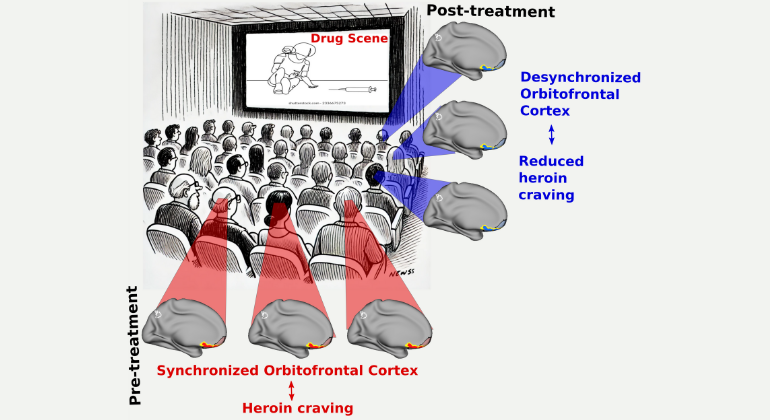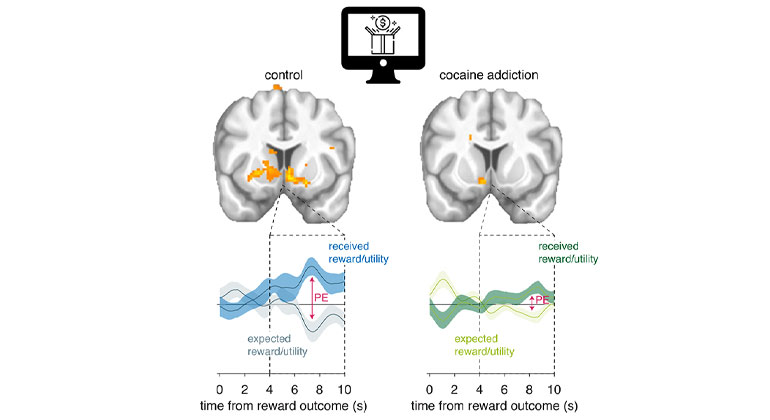Academy Award-Nominated Movie Helps Researchers Identify Brain Region Biased Towards Drug Cues and Treatment Effects in Individuals With Heroin Use Disorder
Work establishes new paradigm for studying drug addiction with naturalistic stimuli that resemble the real, lived experiences of patients

Graphical representation of the study. Image credit: Mount Sinai Health System
Mount Sinai researchers have found that a brain region that is implicated extensively in value-based decision-making and craving in people with heroin use disorder – known as the orbitofrontal cortex (OFC) – shows synchronized responses biased towards drug content, outcompeting other typical subjects of attention and motivation, in a group of individuals with heroin use disorder who watched “Trainspotting,” the Academy Award-nominated 1996 movie about people who use heroin in Scotland.
Importantly, the research team also found that the OFC’s bias toward drug stimuli was significantly reduced in people who underwent treatment/abstinence from drugs. The study results appear in the May issue of Brain.
A core process in drug addiction is maladaptive salience attribution—the process by which the brain selectively focuses motivated attention on certain stimuli and gives them a sense of importance, often at the expense of other stimuli—to drug cues. In other words, with repeated drug use, drug-related stimuli, cues, and context begin to outcompete other typical rewards and reinforcers—such as food, sex, or social connection—for attention and motivation. In effect, for individuals with drug addiction, their reinforcing environment begins to “shrink” to become narrowly focused on drugs.
Previous neuroimaging studies of this phenomenon have looked at brain responses to repeated presentations of images of different types of stimuli, such as drugs, drug paraphernalia, or food. In this study, the Mount Sinai research team assessed salience attribution to drug cues using “Trainspotting” as a more realistic, dynamic, and complex stimulus. Using a movie with a narrative centered on the lived experience of individuals with heroin use disorder (or any psychiatric disorder) for this type of research has never been done before.
“In drug addiction, a drug-themed movie can function like a highly engaging mirror of a real-world drug environment in a way static images cannot, evoking brain processes that are closer to the lived experience of the person, which thereby improves the ecological validity of our functional magnetic resonance imaging (fMRI) studies of the brain,” said Rita Goldstein, PhD, Professor of Psychiatry, and Neuroscience, at the Icahn School of Medicine at Mount Sinai and senior author of the paper. “By imaging the brain while study participants watched the movie, we found several brain regions that responded to the movie in a manner that was biased towards the drug content in individuals with heroin use disorder. In particular, when watching the movie, the OFC responded to drug cues at the expense of other scenes. This result highlights the challenges of daily experience for individuals with substance use disorder.”
For the study, 30 inpatient individuals with heroin use disorders (24 male) and 25 healthy controls (16 male) watched the first 17 minutes of ”Trainspotting” while in an fMRI scanner at baseline and at follow-up after 15 weeks of inpatient treatment that encompassed standard of care with medications for opioid use disorder, relapse prevention and stress management, and group therapies (for the individuals with heroin use disorder). Individuals without addiction did not receive treatment, but the control group was also scanned twice, at baseline and 15 weeks later, to control for time and test-retest effects.
In analyzing these fMRI data, the research team adapted a reverse correlation method to identify the movie content that elicited synchronized fMRI responses in each group. They then measured the degree of shared bias towards drug content in the movie when both drug and non-drug stimuli were presented within this same dynamic narrative context. They also measured self-reported drug craving, which is a typical and well-validated treatment outcome that changes with abstinence and predicts clinical outcomes, in the individuals with substance use disorders.
“In addition to finding that the OFC showed synchronized responses that were biased towards drug content in the individuals with heroin use disorder, we were encouraged to find that with abstinence and treatment, there was recovery whereby this brain region normalized and responded less to the drug content,” said Greg Kronberg, PhD, postdoctoral fellow in the Department of Psychiatry at the Icahn School of Medicine at Mount Sinai and first author of the study. “Finding functional recovery in the OFC with just three months of treatment, with a link to reduced craving, was both surprising and very notable. It is the first evidence of such recovery that points towards avenues for improving treatment.”
“We did not find similar effect when using a static picture-based task, which suggests that movie fMRI, and especially using a movie tailored to the specific concerns of a unique patient population, is more sensitive to the effects of treatment and recovery in psychiatric research in general” added Dr. Goldstein.
The authors note some limitations of the study, including that it used only one movie and that all participants with heroin use disorder were in an inpatient treatment program and abstinent from drug use at the time of the study, so the researchers could not distinguish the contribution of abstinence itself vs. treatment for these recovery processes. Future studies are needed to validate these results with other movies, other substance use disorders, and other phases within the addiction cycle.
The Mount Sinai team is now developing a real-time neurofeedback protocol in which study participants are shown their brain activity in real time with the goal of training them to modulate activity towards a target value. They are testing whether such real-time neurofeedback, provided during watching of the drug-themed movie, could help facilitate recovery in people with substance use disorders. They are also running studies to test these methods with several other movies, where one goal is to use this naturalistic drug cue reactivity platform to test for menstrual phase differences in women with addiction.
About the Mount Sinai Health System
Mount Sinai Health System is one of the largest academic medical systems in the New York metro area, with 48,000 employees working across seven hospitals, more than 400 outpatient practices, more than 600 research and clinical labs, a school of nursing, and a leading school of medicine and graduate education. Mount Sinai advances health for all people, everywhere, by taking on the most complex health care challenges of our time—discovering and applying new scientific learning and knowledge; developing safer, more effective treatments; educating the next generation of medical leaders and innovators; and supporting local communities by delivering high-quality care to all who need it.
Through the integration of its hospitals, labs, and schools, Mount Sinai offers comprehensive health care solutions from birth through geriatrics, leveraging innovative approaches such as artificial intelligence and informatics while keeping patients’ medical and emotional needs at the center of all treatment. The Health System includes approximately 9,000 primary and specialty care physicians and 10 free-standing joint-venture centers throughout the five boroughs of New York City, Westchester, Long Island, and Florida. Hospitals within the System are consistently ranked by Newsweek’s® “The World’s Best Smart Hospitals, Best in State Hospitals, World Best Hospitals and Best Specialty Hospitals” and by U.S. News & World Report's® “Best Hospitals” and “Best Children’s Hospitals.” The Mount Sinai Hospital is on the U.S. News & World Report® “Best Hospitals” Honor Roll for 2025-2026.
For more information, visit https://www.mountsinai.org or find Mount Sinai on Facebook, Instagram, LinkedIn, X, and YouTube.
